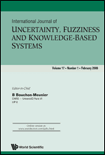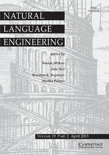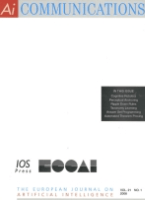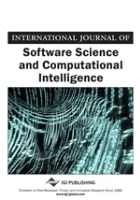
MACHINE LEARNING
Scope & Guideline
Unveiling the Power of Data-Driven Intelligence
Introduction
Aims and Scopes
- Algorithm Development and Optimization:
Research dedicated to creating and enhancing algorithms for machine learning tasks, including efficiency improvements, optimization techniques, and novel algorithmic strategies. - Statistical and Probabilistic Methods:
Studies that explore statistical models and probabilistic reasoning in machine learning, emphasizing inference, decision-making under uncertainty, and the integration of statistical learning principles. - Applications Across Domains:
Application-driven research showcasing how machine learning techniques can be applied in various fields such as healthcare, finance, sports analytics, and natural language processing. - Interpretable and Explainable AI:
Research focused on making machine learning models interpretable and explainable, addressing the need for transparency and understanding in AI systems. - Reinforcement Learning:
Studies within the reinforcement learning paradigm, including applications in robotics, gaming, and real-world decision-making scenarios. - Data Handling and Preprocessing Techniques:
Research that delves into methodologies for handling imbalanced datasets, feature selection, data augmentation, and preprocessing strategies essential for effective machine learning.
Trending and Emerging
- Federated Learning and Privacy-Preserving Techniques:
An increasing emphasis on federated learning frameworks that allow for decentralized model training while preserving user privacy, reflecting growing concerns regarding data security. - Explainable AI (XAI):
A significant trend toward developing methods that enhance the interpretability and transparency of machine learning models, addressing the demand for accountability in AI systems. - Integration of Multi-Modal Data:
Research focusing on the integration of diverse data types and sources (e.g., textual, visual, and sensory data) for comprehensive model training and improved performance. - Meta-Learning and Transfer Learning:
An emerging focus on techniques that facilitate learning from fewer examples and transferring knowledge across tasks, which is particularly relevant in environments with limited data. - Robustness and Adversarial Learning:
A growing interest in developing models that are resilient to adversarial attacks and capable of maintaining performance in the presence of noise and perturbations. - Neural Architecture Search and Automated Machine Learning (AutoML):
An increasing trend toward automated methods for model selection and hyperparameter tuning, streamlining the process of machine learning model development.
Declining or Waning
- Traditional Supervised Learning:
While traditional supervised learning remains significant, its prominence appears to be waning in favor of more complex learning paradigms such as deep learning and reinforcement learning. - Rule-Based Learning Methods:
The focus on classical rule-based learning approaches is decreasing as newer, more flexible methods like deep learning and ensemble methods gain traction. - Static Models without Adaptation:
Research involving static models that do not adapt to changing data distributions is becoming less common, as the need for models that can handle dynamic and evolving datasets grows.
Similar Journals

INTERNATIONAL JOURNAL OF UNCERTAINTY FUZZINESS AND KNOWLEDGE-BASED SYSTEMS
Navigating the complexities of knowledge and uncertainty.Welcome to the INTERNATIONAL JOURNAL OF UNCERTAINTY FUZZINESS AND KNOWLEDGE-BASED SYSTEMS, a prestigious publication dedicated to advancing the fields of artificial intelligence, control systems engineering, information systems, and software research. Published by WORLD SCIENTIFIC PUBL CO PTE LTD in Singapore, this journal serves as a vital forum for the dissemination of innovative theories, methodologies, and applications rooted in the coexistence of uncertainty and fuzziness within knowledge-based systems. With its ISSN 0218-4885 and E-ISSN 1793-6411, the journal consistently ranks in the Q3 category across various Scopus categories, including Control and Systems Engineering and Information Systems, reflecting its influential position in the academic community. Researchers and practitioners alike will find valuable insights and the latest trends through its comprehensive articles, making this journal an essential resource for those seeking to navigate the complexities of this evolving field.

Applied Computing and Informatics
Exploring the Frontiers of Computer Science ApplicationsApplied Computing and Informatics, published by Emerald Group Publishing Ltd, is a prominent open-access journal that has been serving the academic community since 2011. With a focus on advancing the fields of Computer Science Applications, Information Systems, and Software, this journal has established itself as a noteworthy publication, currently ranking in the Q3 quartile for each of its categories in 2023. The journal is particularly recognized for its commitment to disseminating high-quality research, as evidenced by its impressive Scopus rankings—placing it in the 92nd percentile for Computer Science Applications and the 91st percentile for both Information Systems and Software. Based in Saudi Arabia, it adopts a global perspective, inviting contributions from researchers worldwide. With its open-access policy, Applied Computing and Informatics ensures that cutting-edge research is accessible to a broad audience, fostering collaboration and innovation within the computing and informatics disciplines. This journal is an essential resource for academics, professionals, and students seeking to keep abreast of the latest trends and developments in their field.

JOURNAL OF EXPERIMENTAL & THEORETICAL ARTIFICIAL INTELLIGENCE
Bridging Theory and Experimentation in Artificial IntelligenceThe Journal of Experimental & Theoretical Artificial Intelligence, published by Taylor & Francis Ltd, serves as a premier platform for researchers and professionals interested in advancing the fields of artificial intelligence, software engineering, and theoretical computer science. Established in 1989, this peer-reviewed journal features original research and comprehensive reviews that explore innovative methodologies and emerging trends within these dynamic domains. With an impact factor that reflects its relevance, the journal currently ranks in Q3 across its categories, affirming its contributions to the scholarly community. The journal's commitment to quality and rigor invites submissions that bridge experimental and theoretical frameworks, thus fostering a deeper understanding of AI's applications and implications. Researchers and students can access insightful articles that drive critical discussions and inspire future work, making this journal an essential resource for anyone looking to delve into the complexities of artificial intelligence and its surrounding disciplines.

Natural Language Engineering
Unleashing the Power of Language through EngineeringNatural Language Engineering is a premier journal published by Cambridge University Press, dedicated to advancing the field of artificial intelligence and its intersection with linguistics and software. Since its inaugural publication in 1995, the journal has established itself as a vital platform for innovative research and development in natural language processing (NLP) and engineering. With a notable impact factor reflecting its influential contributions, it ranks in the top tiers across various categories, including Q1 in Linguistics and Language and Q3 in Artificial Intelligence. Researchers and practitioners alike benefit from the opportunity to access insightful articles that address both theoretical aspects and practical applications of NLP technologies. Although it operates under a traditional subscription model, the rigorous peer-review process ensures high-quality publications that foster academic discourse and collaboration within the community. This journal is essential for anyone interested in the evolving landscape of language engineering, making it a cornerstone reference for upcoming scholars and seasoned professionals aiming to push the boundaries of knowledge in this dynamic field.

AI COMMUNICATIONS
Pioneering Discussions on AI Methodologies and Implications.AI COMMUNICATIONS is a distinguished journal published by IOS PRESS, focusing on the dynamic field of Artificial Intelligence. With a rich history dating back to 1987, this journal covers a broad spectrum of topics, including the latest advancements in AI methodologies, applications, and implications for society. Despite holding a Q3 classification in the 2023 category of Artificial Intelligence, it provides an essential platform for dialogue and dissemination of research, highlighted by its global accessibility in the realm of AI communications. Researchers, professionals, and students alike will find a wealth of knowledge within its pages, which aim to bridge the gap between cutting-edge research and practical applications in AI. By contributing to this journal, authors have the potential to engage with a diverse audience and impact the ongoing discourse surrounding artificial intelligence technologies.

JOURNAL OF MACHINE LEARNING RESEARCH
Pioneering Insights in Artificial Intelligence and BeyondJOURNAL OF MACHINE LEARNING RESEARCH, published by MICROTOME PUBL, stands as a premier journal in the realms of Artificial Intelligence, Control and Systems Engineering, Software, and Statistics and Probability. With an impressive Q1 ranking across multiple categories and a prominent Scopus ranking that places it among the top journals in its field—ranked 1st in Mathematics and 20th in both Artificial Intelligence and Software—this journal serves as a vital resource for cutting-edge research and advancements in machine learning. Established in 2001, it has been committed to disseminating high-quality research findings and innovative methodologies, addressing the evolving challenges and opportunities in machine learning. Furthermore, the journal maintains a rigorous peer-review process, ensuring that only the most significant contributions are published. With open access options available and a strong user-friendly platform, it invites researchers, professionals, and students to engage deeply with the pioneering work in the field.

NEURAL COMPUTING & APPLICATIONS
Unlocking the Potential of Neural AlgorithmsNEURAL COMPUTING & APPLICATIONS is a premier journal dedicated to the burgeoning fields of Artificial Intelligence and Software Engineering, published by Springer London Ltd. Established in 1993, the journal serves as a pivotal platform for disseminating cutting-edge research and innovative applications in neural computing, covering a broad range of topics from algorithm development to real-world applications. With its impressive categorization in the 2023 Journal Quartiles—ranging Q2 in Artificial Intelligence and Q1 in Software—it stands out in its discipline, ranking 42nd out of 407 in Computer Science Software and 50th out of 350 in Computer Science Artificial Intelligence, reflecting its significant impact in the academic community. Although not an open access journal, it provides vital access to significant findings and methodologies that drive advancements in technology. Researchers, professionals, and students looking to stay abreast of the most relevant and impactful developments in these fields will find NEURAL COMPUTING & APPLICATIONS an indispensable resource.

International Journal of Software Science and Computational Intelligence-IJSSCI
Pioneering Research in Software Science and Computational IntelligenceInternational Journal of Software Science and Computational Intelligence (IJSSCI) is a prominent academic journal published by IGI Global, dedicated to advancing the fields of software science and computational intelligence. With its ISSN 1942-9045 and E-ISSN 1942-9037, IJSSCI offers a platform for researchers, practitioners, and students to disseminate innovative research findings, theoretical advancements, and practical applications in areas such as algorithm development, machine learning, and software engineering. Although the journal currently does not operate under an open access model, its rigorous peer-review process ensures high-quality publications that contribute significantly to the academic discourse. Based in Hershey, PA, IJSSCI is recognized for its commitment to fostering collaboration among professionals in the technology and computer science fields, making it an essential resource for those looking to stay at the forefront of software science advancements.

Machine Learning and Knowledge Extraction
Driving Innovation in Artificial Intelligence and EngineeringMachine Learning and Knowledge Extraction, published by MDPI, is an esteemed Open Access journal that has been at the forefront of disseminating cutting-edge research since its inception in 2019. Based in Switzerland, this journal has established itself as a significant contributor to the fields of Artificial Intelligence and Engineering, currently ranking in the Q2 category in Artificial Intelligence and Q1 in Engineering (miscellaneous) for 2023. With a notable Scopus ranking, it holds the 35th position out of 204 in Engineering, placing it in the 83rd percentile, while it ranks 127th out of 350 in Computer Science, reaching the 63rd percentile. Machine Learning and Knowledge Extraction serves as a vital platform for researchers, professionals, and students alike, promoting insightful discussions, innovative methodologies, and profound discoveries in machine learning and data extraction techniques. The journal's open access model ensures that groundbreaking research is widely accessible, fostering collaboration and advancing knowledge across various disciplines.

INTERNATIONAL JOURNAL OF APPROXIMATE REASONING
Pioneering Insights in Applied Mathematics and AIThe INTERNATIONAL JOURNAL OF APPROXIMATE REASONING, published by Elsevier Science Inc, stands as a pivotal resource in the domains of applied mathematics and artificial intelligence. Since its inception in 1987, the journal has evolved into a leader in its field, boasting an impressive impact factor and ranking within the top quartile for applied mathematics (Q1) and high standings in artificial intelligence and software categories according to the 2023 Scopus rankings. As researchers, professionals, and students delve into complex issues surrounding reasoning under uncertainty, this journal provides invaluable insights and cutting-edge research. In addition to its rich content, the journal's commitment to advancing knowledge in theoretical computer science further enhances its significance in fostering academic growth. While the journal does not currently offer open access, its rigorous peer-review process ensures that only high-quality, impactful studies are published, solidifying its role as an essential source for academics striving to remain at the forefront of their fields.